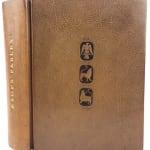Philip Smith
Publii Terentii Afri, Comoediae; Phaedri, Fabulae Aesopiae; Publii Syri, Sententiae, 1726
London: Cornelius Crownfield
1538
Further images
Thick octavo. (vii), xxv, 444; (viii) (88)pp. Engraved frontispiece portrait of Frederick Lewis, Prince of Wales by George Vertue; engraved frontispiece facing Phaedrus title page showing Aesop communicating with the...
Thick octavo. (vii), xxv, 444; (viii) (88)pp. Engraved frontispiece portrait of Frederick Lewis, Prince of Wales by George Vertue; engraved frontispiece facing Phaedrus title page showing Aesop communicating with the animals below an eagle bearing the portrait of William August, Duke of Cumberland. The first edition of these works edited and with notes by noted classical scholar Richard Bentley. This copy features a binding by Philip Smith of full olive brown oasis morocco over beveled boards, signed with his monogram in the rear turn-in and dated 1955. Upper cover tooled with three cartouches arranged vertically, and separated by small diamond-shaped devices. Title in gilt on spine with blind-tooled dots between letters and repeating the diamond-shaped devices between words. A signed, typed note by Smith on rear paste-down outlines the entire scope of the rebinding. This is an early work by Smith, the tooling for which is identical to a binding he executed two years earlier that appeared in Maggs's 1996 Bookbinding in the British Isles (337). At the time, the Maggs cataloguer noted that work was completed while Smith was still a student at the Royal College of Art, where he trained under Roger Powell, but took inspiration for his designs from Peter Waters. The cartouches used in the present work - fittingly, an eagle, a lion and a bull - appeared at the corners of of the earlier work. This was likely an early restoration commission by Smith, executed during his tenure teaching art and bookbinding at Malvern College of Art, prior to his apprenticeship with Sidney Cockerell. Spine slightly sunned, few shallow scuffs to upper cover, two apparent wormholes at very bottom edge of spine on either side. Overall, a nearly fine example of Smith's earliest work as an independent bookbinder.













